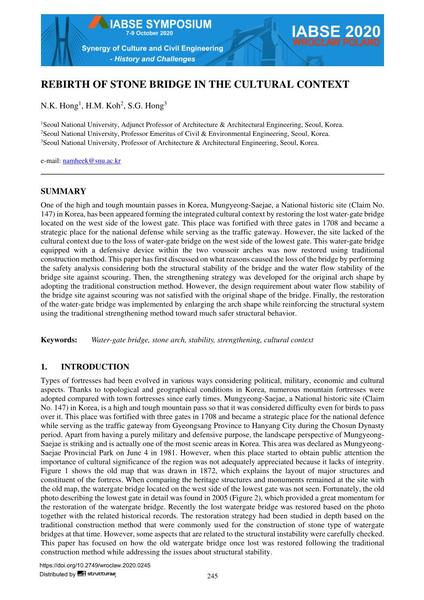Rebirth of Stone Bridge in the Cultural Context

|
|
|||||||||||
Bibliografische Angaben
| Autor(en): |
N. K. Hong
H. M. Koh S. G. Hong |
||||
|---|---|---|---|---|---|
| Medium: | Tagungsbeitrag | ||||
| Sprache(n): | Englisch | ||||
| Tagung: | IABSE Symposium: Synergy of Culture and Civil Engineering – History and Challenges, Wrocław, Poland, 7-9 October 2020 | ||||
| Veröffentlicht in: | IABSE Symposium Wroclaw 2020 | ||||
|
|||||
| Seite(n): | 245-251 | ||||
| Anzahl der Seiten (im PDF): | 7 | ||||
| Jahr: | 2020 | ||||
| DOI: | 10.2749/wroclaw.2020.0245 | ||||
| Abstrakt: |
One of the high and tough mountain passes in Korea, Mungyeong-Saejae, a National historic site (Claim No. 147) in Korea, has been appeared forming the integrated cultural context by restoring the lost water-gate bridge located on the west side of the lowest gate. This place was fortified with three gates in 1708 and became a strategic place for the national defense while serving as the traffic gateway. However, the site lacked of the cultural context due to the loss of water-gate bridge on the west side of the lowest gate. This water-gate bridge equipped with a defensive device within the two voussoir arches was now restored using traditional construction method. This paper has first discussed on what reasons caused the loss of the bridge by performing the safety analysis considering both the structural stability of the bridge and the water flow stability of the bridge site against scouring. Then, the strengthening strategy was developed for the original arch shape by adopting the traditional construction method. However, the design requirement about water flow stability of the bridge site against scouring was not satisfied with the original shape of the bridge. Finally, the restoration of the water-gate bridge was implemented by enlarging the arch shape while reinforcing the structural system using the traditional strengthening method toward much safer structural behavior. |
||||
| Stichwörter: |
Stabilität Verstärkung
|
||||
